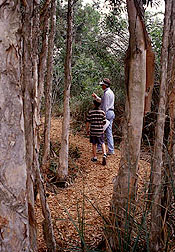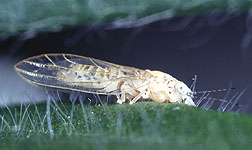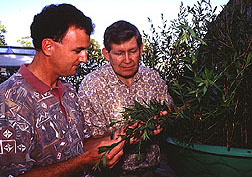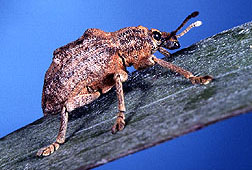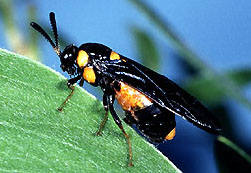Aussie Weevil Opens Attack on Rampant Melaleuca
|
|
Hardworking insects imported from Australia to attack melaleuca trees may help stop this weed from overrunning Florida's Everglades.
Native to Australia, melaleuca has successfully invaded more than a half-million acres in central and southern Florida since the early 1900s. The trees take over an estimated average of 14 to 15 acres a day, threatening to destroy the delicate Everglades ecosystem.
Agricultural Research Service scientists and cooperators freed the grey-brown melaleuca leaf weevil, Oxyops vitiosa, for the first time in the United States this year, turning loose about 1,600 of the short-snouted insects at 11 key melaleuca-infested sites in Florida. Their work marks the first time that any melaleuca-munching organism has ever been used in this country for classical biological control; that is, the use of one introduced organism to control another.
The weevil's U.S. debut resulted from more than a decade of scrutiny by ARS scientists based in Australia and Florida. Their outdoor investigations in Australia—and laboratory and greenhouse tests both there and in Florida—showed that the quarter-inch-long weevil would not eat desirable plants on farms or in gardens, nurseries, and parks. Those experiments included not only testing on melaleuca relatives like bottlebrush and eucalyptus, but also on fruit and nut trees, shrubs, and many native plants.
|
|
Weevil adults and grubs, or larvae, feed voraciously on melaleuca's young, silvery leaves. This stunts the plant's growth and leaf production, says entomologist Ted D. Center, who is in the ARS Aquatic Weed Control Research Unit at Fort Lauderdale. He directs Florida studies that now include careful monitoring of the weevil's success in colonizing the state's melaleuca groves.
More of a Good Thing
Scientists want to augment the weevils with other industrious insects. The most promising candidates include four additional species native to Australia: a beneficial sawfly, a sap-feeding psyllid (SILL-id), a tube-dwelling moth, and a gall-forming fly. ARS scientists are the first to extensively study the potential of this quartet of little-known insects to thwart melaleuca—and only melaleuca.
|
|
These rigorous tests garnered the first-ever federal and state approvals to ship the sawfly and psyllid to Florida for indoor study at the Gainesville lab. It's a high-security quarantine site, meaning that test insects can't sneak outdoors. Entomologist Gary R. Buckingham of the ARS Aquatic Weed Control Research Unit heads the Gainesville studies.
Portrait of the Enemy
Known to botanists as Melaleuca quinquenervia, this invasive pest is native to Australia and a few neighboring islands. Layers of paper-thin bark give the weed its "paperbark tree" nickname. Thirsty and fast-growing, melaleuca was brought to this country in 1906 and widely planted, in an attempt to dry up Florida marshes and swamps. It is not a pest in Australia.
A mature melaleuca tree produces millions of brownish-black seeds every year, each about the size of a pepper grain. Even if only a few of these seeds sprout, vigorous melaleuca saplings can quickly crowd out native plants, says entomologist Joseph K. Balciunas. Now at the ARS Western Regional Research Center in Albany, California, Balciunas is former director of the ARS Biological Control Laboratory at Townsville, Australia.
|
|
While there, he led pioneering investigations that revealed biological control candidates. Balciunas did this work for ARS from 1989 to 1995 with co-researchers Matthew F. Purcell and Peter K. Jones of Australia's CSIRO, or Commonwealth Scientific and Industrial Research Organization, in Brisbane; and Damien W. Burrows of the Australian Center for Tropical Freshwater Research, James Cook University, Townsville, Australia.
The ARS lab—now headquartered in Brisbane and previously in Townsville at James Cook University—is jointly operated by ARS and CSIRO. Balciunas was succeeded as lab director in 1996 by Charles W. Turner, an ARS research botanist who died in 1997.
The Agents' Modus Operandi
Biological control researchers agree that the insect most likely to follow the melaleuca leaf weevil may be the sawfly Lophyrotoma zonalis. Larvae of this aggressive herbivorous insect have a hearty appetite for tough old melaleuca foliage.
Each inch-and-a-quarter-long sawfly larva "has a tiny horn on its back, making it look something like a little hornworm caterpillar," says Buckingham. His greenhouse tests demonstrated that a troop of 100 sawfly larvae can destroy every leaf on a 10-foot-high melaleuca sapling in only 3 or 4 days.
Melaleuca's clear sap makes a nutritious meal for a sap-sucking insect known as Boreioglycaspis melaleucae, or melaleuca psyllid. Psyllids are also called jumping plant lice because the highly active adults, which resemble miniature cicadas, jump between leaves and plants when alarmed.
|
|
Both the adults and young, or nymphs, feed on melaleuca sap. Nymphs cause the most harm, severely damaging seedlings. In tests conducted by Balciunas, Purcell, and Jones, it took about 500 nymphs only a week or two to cause leaves of potted melaleuca saplings to begin curling and withering. After about a month of this onslaught, some besieged saplings died.
Psyllid nymphs, says Balciunas, typically form a communal shelter of delicate white threads. These house dozens of nymphs, making it easy for scientists to find and collect the insects for lab tests there or in Florida.
The leaf-eating larvae of a tube-dwelling moth called Poliopaschia lithochlora "do a competent job of attacking and destroying melaleuca saplings," says Burrows.
To defend themselves, larvae live in colonies, building an elaborate system of sturdy, quarter-inch tubes. They loosely drape the tubes with a whitish-brown webbing. Strong and somewhat like spun silk, the webbing anchors the colony to melaleuca branches. The busy larvae venture from the tubes to gather melaleuca leaves, which they attach to the webbing. A typical network of tubes and webbing may be up to 6 inches long and 4 inches across and may accommodate at least a half-dozen larvae.
|
|
A swelling called a gall makes a cozy home for another kind of melaleuca herbivore. Immature gall-forming flies, members of the genus Fergusonina, share space inside the gall with wriggly microscopic worms called nematodes. The organisms may work together to form the typically conical galls on the tips of melaleuca branches.
"Fully developed galls are usually about the size of a marble," says researcher Purcell at Brisbane. "Galls disrupt flower and seed production because they form where the tree would normally produce new flowers." Adult gall flies resemble very small house flies. The nematodes—a species the researchers haven't yet identified—are C-shaped and transparent or nearly white.
Studies elsewhere with another Fergusonina gall-forming fly showed that nematodes invade the ovaries of the female fly larvae and are later expelled when the female lays her eggs. "That same process," says Purcell, "probably occurs with the fly that inhabits melaleuca galls.
"We're trying to determine if the nematode causes galls or, alternatively, whether galls form in response to some chemical released by the female fly when she lays her eggs. Once we find the answer, we'll know if we need to recruit both organisms, or just one."
|
|
Federal and state agencies cooperating in the research include the U.S. Army Corps of Engineers, National Park Service, Florida Department of Environmental Protection, Florida Department of Agriculture and Consumer Services, South Florida Water Management District, and Dade and Lee Counties. — By Marcia Wood
Joseph K. Balciunas is in the USDA-ARS Exotic and Invasive Weeds Research Unit, 800 Buchanan St., Albany, CA 94710; phone (510) 559-5975
Ted D. Center is in the USDA-ARS Invasive Plant Research Laboratory, 3205 SW College Ave., Fort Lauderdale, FL 33314; phone (954) 475-6543







